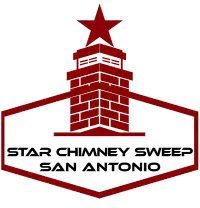Chimney fires are dangerous and can cause significant damage to your home. Knowing the signs of a chimney fire and how to prevent them is crucial for maintaining a safe living environment. This article by Star Chimney Sweep San Antonio will explore the common signs of a chimney fire, the underlying causes, and the best practices for prevention and safety.
What is a Chimney Fire?
A chimney fire occurs when creosote buildup inside the chimney ignites. Creosote is a highly flammable substance formed from unburned wood particles, soot, and tar that accumulate over time. When it ignites, it can cause intense heat and flames, posing a serious risk to your home.
Common Signs of a Chimney Fire
1. Loud Cracking and Popping Noises
One of the most noticeable signs of a chimney fire is loud cracking and popping noises coming from the chimney. These sounds are caused by the burning of creosote and can indicate a serious fire.
2. Dense Smoke
A chimney fire often produces dense, thick smoke that may enter your home or be visible from the chimney top. This smoke can be black or dark gray and is a clear sign of trouble.
3. Intense, Hot Smell
During a chimney fire, you might notice a strong, hot smell similar to that of a burning wood stove. This odor is a result of the intense heat and burning creosote.
4. Visible Flames or Glowing Embers
In severe cases, you might see visible flames or glowing embers inside the chimney or coming from the chimney top. This is a dangerous sign that requires immediate attention.
5. Excessive Creosote Buildup
If you notice excessive creosote buildup during regular inspection, it indicates a higher risk of chimney fires. Regular cleaning and maintenance are essential to prevent this.
6. Damaged Chimney Cap
A damaged or warped chimney cap can be a sign of a chimney fire. The intense heat from a fire can cause the metal cap to bend or crack.
Causes of Chimney Fires
1. Creosote Buildup
The primary cause of chimney fires is the buildup of creosote. This flammable substance can ignite if not regularly cleaned.
2. Improper Use of Fireplace
Burning unseasoned wood or using the fireplace improperly can lead to increased creosote formation and a higher risk of fire.
3. Lack of Maintenance
Neglecting regular chimney inspections and cleanings can result in dangerous creosote buildup and other issues that increase the risk of fire.
4. Structural Damage
Cracks or damage to the chimney structure can allow flames to escape and ignite nearby combustible materials.
Prevention Tips
1. Regular Chimney Inspections
Schedule annual inspections to check for creosote buildup and structural damage. A professional can identify potential issues before they become serious problems.
2. Clean Your Chimney Regularly
Have your chimney cleaned by a professional at least once a year, or more often if you use your fireplace frequently. This removes creosote and other debris that can cause fires.
3. Use Seasoned Wood
Burn only seasoned wood, which has been dried for at least six months. Unseasoned wood produces more creosote and increases the risk of chimney fires.
4. Install a Chimney Cap
A chimney cap prevents debris, animals, and moisture from entering the chimney, reducing the risk of blockage and creosote buildup.
5. Avoid Overloading the Fireplace
Do not overload your fireplace with too much wood. Overloading can cause excessive heat and creosote formation.
6. Use the Right Fireplace Tools
Use appropriate tools to manage the fire and avoid pushing embers into the chimney, which can ignite creosote.
FAQs
1. What are the common signs of a chimney fire?
Common signs include loud cracking and popping noises, dense smoke, an intense hot smell, visible flames or glowing embers, excessive creosote buildup, and a damaged chimney cap.
2. How often should I have my chimney inspected?
It is recommended to have your chimney inspected at least once a year by a professional to check for creosote buildup and structural damage.
3. Can I clean my chimney myself?
While you can clean your chimney yourself, it is advisable to hire a professional to ensure thorough cleaning and to identify any potential issues.
4. What type of wood should I use in my fireplace?
Use only seasoned wood that has been dried for at least six months. Unseasoned wood produces more creosote and increases the risk of chimney fires.
5. How does a chimney cap help prevent fires?
A chimney cap prevents debris, animals, and moisture from entering the chimney, reducing the risk of blockages and creosote buildup.
6. What should I do if I suspect a chimney fire?
If you suspect a chimney fire, evacuate your home immediately and call the fire department. Do not attempt to extinguish the fire yourself.
7. How can I reduce creosote buildup?
To reduce creosote buildup, burn only seasoned wood, avoid overloading the fireplace, and have your chimney cleaned regularly by a professional.
Conclusion
Recognizing the signs of a chimney fire and understanding the causes are crucial for preventing and addressing this dangerous issue. Regular maintenance, proper fireplace use, and professional inspections are key to keeping your home safe. For expert chimney inspection and maintenance services in San Antonio, TX, Contact Star Chimney Sweep San Antonio. Ensure your chimney remains safe and efficient with regular care and attention.
By following these guidelines and tips, you can prevent chimney fires and maintain a safe and comfortable home. Regular inspections and proper use of your fireplace are essential to minimizing the risk of fires.


